Savior of Shanghai's historic buildings
Lou Chenghao, 74, is a man with a mission, obsessed with preserving Shanghai’s cultural legacy. Unlike people of his age who spend their retirement playing mahjong or with grandchildren, Lou walks through the city’s high streets and back lanes with a camera in hand.
At times, he climbs the steep and narrow staircases of the city’s unique shikumen (stone-gated) buildings, or simply listens to stories of people living in old houses — always keeping an account of his travels.
Dubbed a “walking map,” Lou has information about thousands of old buildings on his fingertips, including more than 3,500 that are protected, besides hundreds of longtang, or alleyways, and ancient towns.
Many of the old buildings have been demolished to make way for urban renewal, and shikumen, in particular, are under threat. The unique architectural style, which first appeared in Shanghai in the 1860s, combines Western style with Chinese traditional courtyard elements.
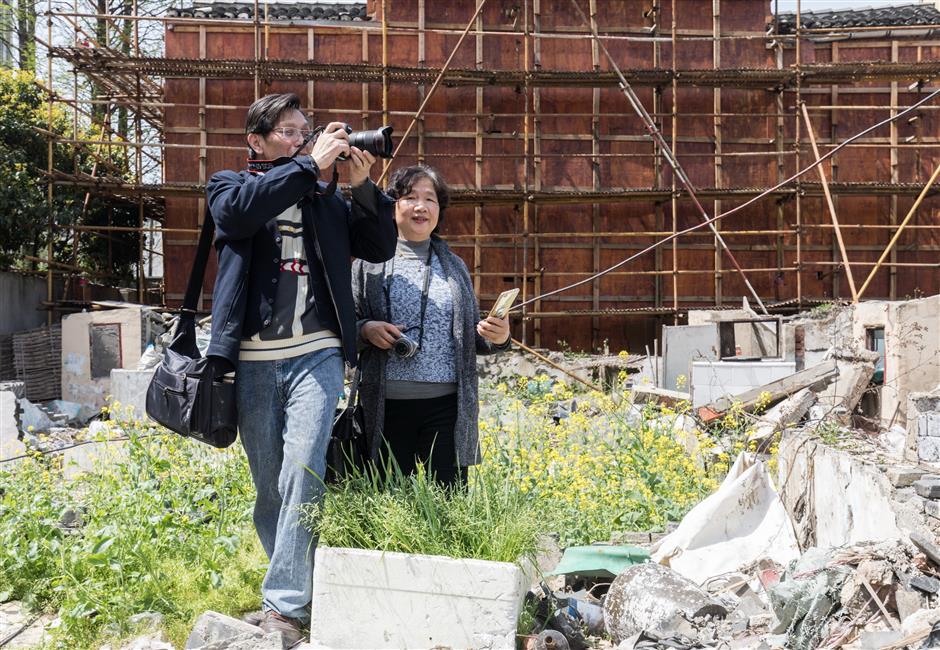
Lou Chenghao often walks through Shanghai’s high back lanes with a camera in hand.
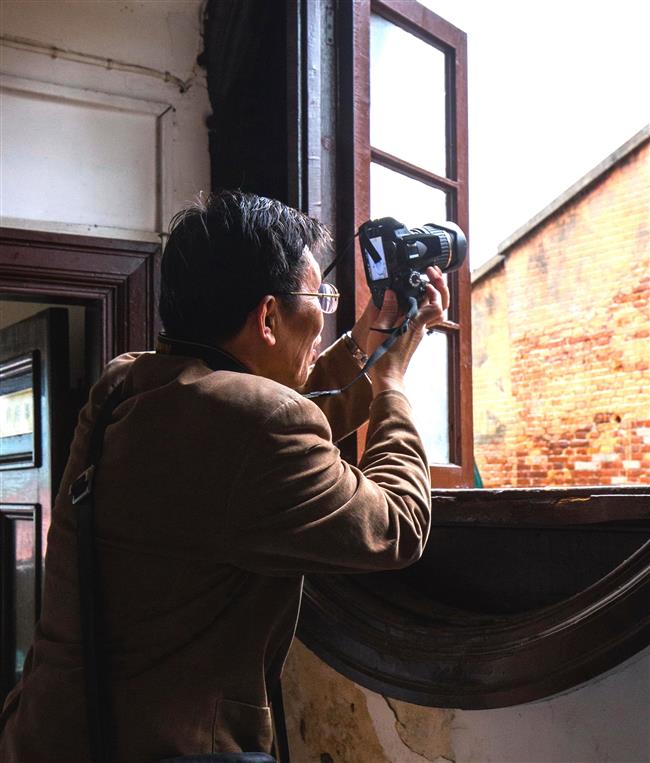
In their heyday, there were more than 9,000 shikumen lanes with 200,000 buildings across Shanghai. Now, 1,900 lanes and around 50,000 buildings remain, according to the top political advisory body in Shanghai.
Today marks the 13th Cultural and Natural Heritage Day of China, which was launched to raise the awareness in the protection of cultural legacies. Nearly 100 historic buildings in Shanghai will open free to the public today.
A Shanghai native, Lou stresses the urgent need to safeguard these old buildings. He has become a wanghong, or Internet celebrity, for unremittingly calling on the government to save the historic sites from bulldozers.
He uses the social media platform Weibo effectively to explain the historical value of the buildings to his 30,000 followers in the hope that they would catch the attention of the authorities as well as the public.
What he got, however, was not just appreciation for his efforts but also brickbats. Some of his critics insisted he was just empty talk.
Lou says it was an arduous task working to save historic buildings. He has been to every site that needed protection — most of them ramshackle demolition sites. To save the Gong Yi Fang shikumen neighborhood, he made trips to the site more than 20 times, even making friends with the residents.
“I have lived in the city for more than 70 years — over 40 years in shikumen — and studied the archives for 50 years. I’m familiar with the city ... People older than me may not have the stamina to travel around and write. So if I don’t do it, who else will?” he asks.
Lou’s daily routine begins at 4:30am when he spends two hours reading posts and comments on Weibo about historic structures, and another two hours online before going to bed at around 9pm.
“That way, I can keep myself informed about things going on in the city,” he says.
Lou worked for about 40 years in the archives division of the former Shanghai Institute of Architectural Design & Research, which handled repairs and renovations of old buildings. He has published more than 200 essays and 15 books on the subject.
In 2008, Lou joined China Construction Design International Group as a chief consultant in the library and archival management department.
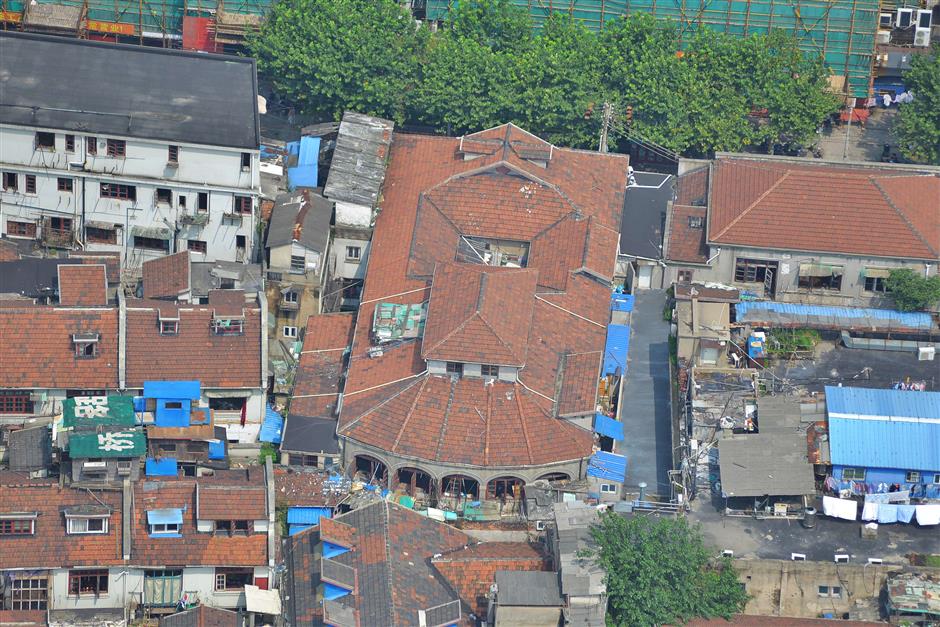
Yihong Garden (center), with arched windows and fan-shaped roofs, has been protected from demolition thanks to Lou's efforts.

Gong Yi Fang, a shikumen community built in 1930, has been saved by Lou from bulldozers.
On weekends and holidays, he attended cultural tours where he got to meet people with similar interests.
One day in 2014, some of these people sent him photos of a huge building in Hongkou District with arched windows and fan-shaped roofs. They asked him to verify the antecedents of the historical structure.
Lou went with them to the site, trying to uncover the history of the building. It was earmarked for demolition and surrounded by shops and illegal structures. Lou and his friends from the group managed to get in and found a stone plaque bearing the name of businessman Zhao Qifeng, from Guangdong Province.
The finding prompted the history-loving veteran to go through his huge collection of books and maps. In that reservoir of knowledge he found that Dr Sun Yat-sen had visited the building several times in the 1910s. Also, that Tang Shaoyi, first prime minister of the Republic of China (1912-49), had held his wedding ceremony there.
The 74-year-old even managed to dig out two pictures from historical records — one showing Sun posing with officials from the China Railway Association in the garden of the building in 1913 and the other of Tang’s wedding the same year.
A comparison of old and current photos confirmed that the building was Yihong Garden, once owned by businessman Zhao.
Lou posted his findings online which immediately attracted thousands of viewers, prompting the district authorities to halt the demolition and put the site on the protection list.
“We were very excited as it was the first time that we had all worked together to protect a historical building,” Lou says, also giving credit to some of his friends who helped him in this venture. “I realized that social media was not just for fun, but could be used as a weapon. It encouraged me to use it to raise public awareness about the importance of saving old structures.”
Since then, Lou has managed to save more than 10 buildings. He says his success is not in halting demolition but in ensuring the sites are granted “protected” status.
He also saved Gong Yi Fang, a shikumen community built in 1930, which featured a gas supply and an independent restroom for each household — a rarity in those times — and a neighborhood that was frequented by celebrated writers like Lu Xun.

Lou has also helped preserve Yilu, a shikumen building near Xintiandi commercial complex.
Then there was the case of protecting Yilu, a shikumen building near Xintiandi. The battle to save it started in 2014 and involved taking on the might of Shui On Group, a well-known Hong Kong developer. It was eventually resolved in January this year with Lou again coming out tops.
Lou is uncomfortable with the “dismantle and reassemble” approach that involves tearing down a building and piecing it back brick by brick.
“You can’t expect the building to be the same after it is demolished in the first place,” says Lou. “It might work on some wooden structures, but it does not help with the brick-and-wooden shikumen structures.”
He cites the case of Jian Ye Li on Jianguo Road W., which was listed as protected architecture in 1994. The shikumen neighborhood was dismantled and rebuilt later by a real estate developer, but critics slammed the new look as fake.
Lou believes the best way to preserve shikumen is to protect the whole community — with residents remaining in the old buildings.
“Houses without people living inside are just like exhibits in museums. They are residential buildings which are vitalized by people. It’s the people living inside who can tell the past and pass on the traditions and heritage from generation to generation,” Lou says. “So they should not be redeveloped into commercial stores, restaurants or hotels.”
But not all shikumen residents are in agreement with him. Many of them complain about the dilapidated state of the structures, the lack of living space and having to share kitchens and toilets with other families.
“Do you know how hard life is in shikumen?” a critic said on his Weibo account. Others suggested he move into one of the shikumen houses “to experience their difficulties.”
But Lou, who himself grew up in a shikumen neighborhood near People’s Square, says, “I have lived in shikumen for more than four decades, so I know what life is like in those buildings. But shikumen houses are also historical and cultural heritage of the society. It’s our responsibility to protect distinctive legacy.”
Lou, however, does admit that overcrowding is a problem for many shikumen residents.
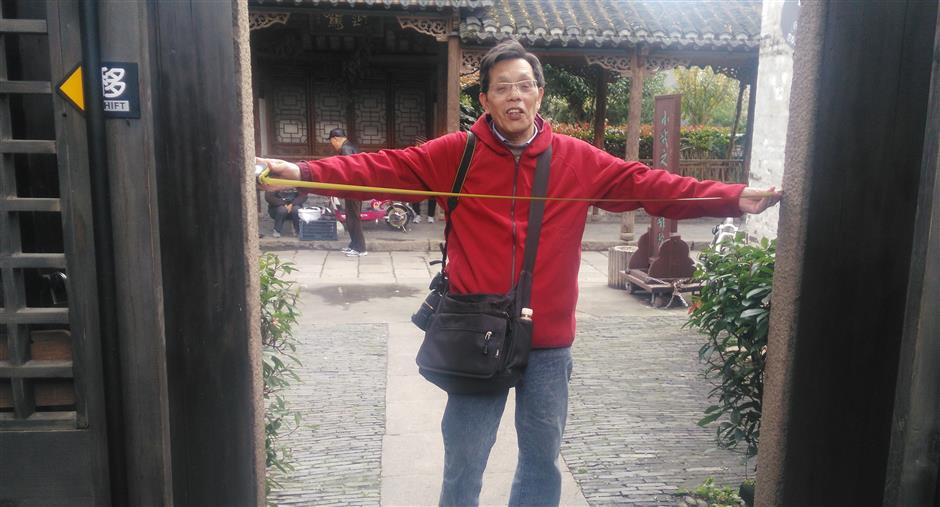
Lou measures the gate of a traditional residential building in Xinchang Town of the Pudong New Area.
Originally, one shikumen block was designed for one family, but over time it became crowded after being subdivided into several units and shared by several families. It is not rare to see five or six people living in a 15-square-meter room even now.
“I don’t gain anything in trying to protect these structures,” Lou says. “My only purpose is to preserve the city’s history and culture.”
Lou’s efforts have been recognized by some districts’ cultural heritage bureaus. Many of them seek him out for advice and suggestions on preservation. He was also a member of a historic building preservation panel of Jing’an District.
Lou is glad to see the government and the general public have attached more importance to historic buildings in recent years.
“The government has changed its policy on old buildings, while the protection target has also been expanded from single buildings to neighborhoods,” he says.
As China celebrates Cultural and Natural Heritage Day today, Lou says he is focusing on spreading the culture and history of the buildings to more people.
“I have seen mistakes in some online posts and even media reports about some buildings,” he says. “I wish to correct them by publishing books, giving lectures and urging people to check out the buildings themselves.”
Lou organizes free tours, during which he explains the architectural styles, facades, windows and tiles to the participants.
He says historic buildings show the city’s unique culture and history, something modern skyscrapers fail to do.
“Look at the new buildings. Can you see any Chinese characteristics in them? No. We can see similar buildings in any part of the world,” Lou says. “None of them deserve to be protected as a cultural legacy 100 years later.”
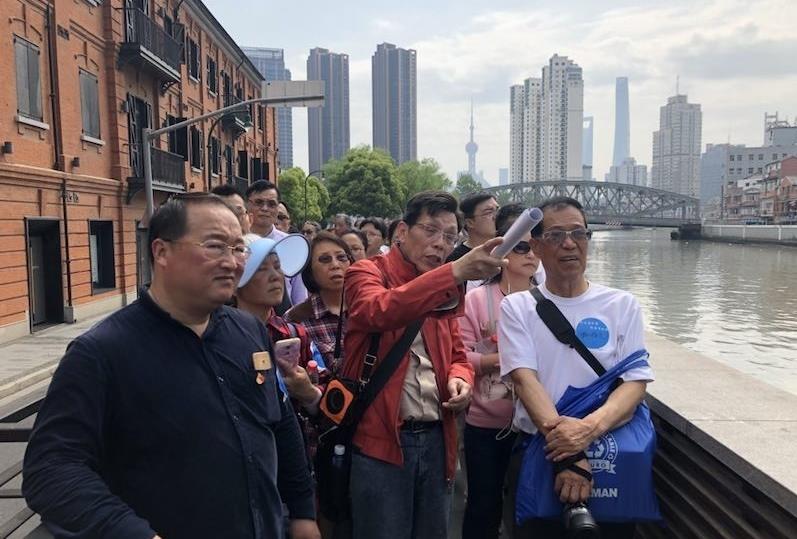
Lou (center in red) explains the history and features of historic buildings during a walking tour along Suzhou Creek in Jing'an District.
















